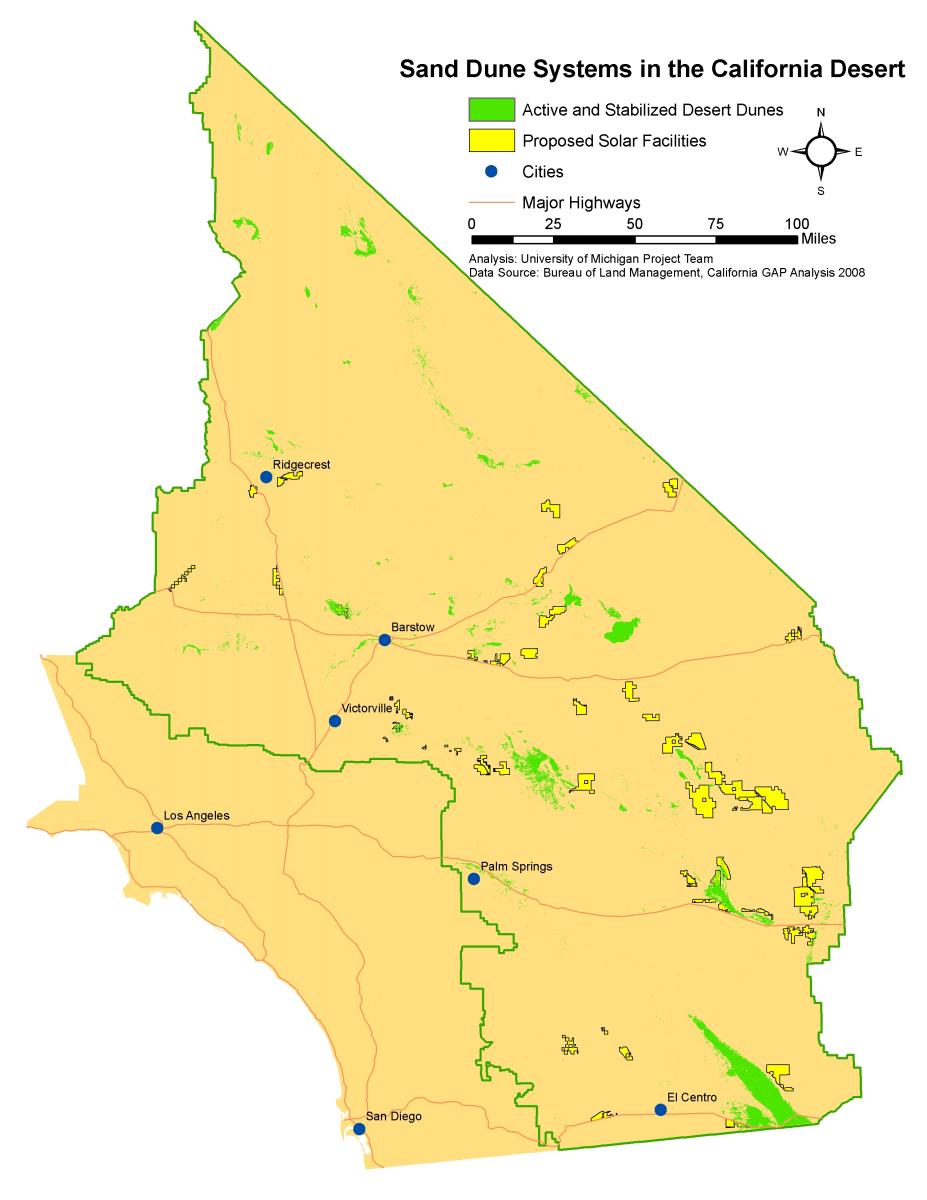Ecological Impacts
Aeolian Wind Processes: Sand Dune Systems
Solar facilities that are built on top of dry water channels, washes, or playas, or that are constructed on or near alluvial fans (also called bajadas), may interfere with the sediment deposition that sustains desert sand dune systems. Solar facilities constructed in wind corridors risk interrupting or blocking the transport of sediment to these dune systems. A solar facility site that has hundreds to thousands of acres of infrastructure, potentially with energy-capturing structures up to 40 feet tall, such as dish/engines, may be large enough to create wind barriers.
The placement of solar facilities in the proximity of sand dune systems may also negatively affect dune endemic biodiversity (Map 1) by fragmenting habitat. Roads could become a source of roadkill mortality, and perimeter fencing and buildings on-site could provide hunting perches for avian predators. The cumulative effect of new utility-scale solar facilities and current impacts to sand dune systems (e.g., OHV recreation, urban and suburban development, and invasive species) may exert even greater pressure on these already threatened systems.
Habitat Connectivity
Solar development may affect species migration if facilities are sited in pre-existing or potential migration corridors, including corridors utilized by both limited-range species (such as desert tortoises) and wide-range species (like bighorn sheep). Inability to access food and water could have immediate impacts on population viability, leading to mortality; in small populations, decreases in population size can have long-term impacts from a shrinking gene pool.1 Similarly, sustained migration corridor blockage can decrease evolutionary fitness of a population or metapopulation by placing long-term restrictions on gene-flow.2
The placement of solar facilities in key migration corridors may limit a species’ ability to adapt to future changes in climate. Changes in temperature and precipitation may result in the spatial shift of suitable habitats, and it may be necessary for some species to adjust ranges to reflect this shift. Inability by individuals or populations to access suitable climates or resources could lead to species decline.
Disturbed vs. Undisturbed Land
Whether a facility is placed on undisturbed natural areas or land that has already been disturbed, influences the magnitude of impact caused by solar development. There is greater potential for disturbed areas to have already undergone land modifications like grading, vegetation removal, and soil compaction. Facility placement on undisturbed lands may result in a significant departure from existing natural conditions than if the facility was placed on disturbed lands. If facilities are placed on disturbed lands (e.g. abandoned agriculture), there is a higher likelihood that biological soil crusts have already been destroyed and have not returned. Conversely, if facilities are sited on undisturbed lands, there is a higher likelihood of soil crusts being present on-site. Facilities placed in disturbed areas may have a relatively smaller contribution to the establishment and spread of invasive plants in the area than facilities placed in undisturbed areas. Invasive plants may already be established on disturbed lands and the development of a solar facility may not result in a significant departure from existing conditions. Conversely, the placement of a facility on undisturbed lands may result in the initial establishment of invasive plants on and around the site.
1 K.L. Penrod, E.S. Rubin, and C. Paulman, “Mojave Desert Habitat Connectivity ~ Phase 1: A Brief Overview of the Mojave Desert’s Previously Identified Areas of Ecological Significance,” SC Wildlands, Fair Oaks, CA, 2009.
2 K.L. Penrod, E.S. Rubin, and C. Paulman, “Mojave Desert Habitat Connectivity ~ Phase 1: A Brief Overview of the Mojave Desert’s Previously Identified Areas of Ecological Significance,” SC Wildlands, Fair Oaks, CA, 2009.

